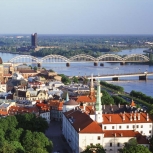
Riga
With more than 1 million inhabitants, this capital city is home to nearly half the population of Latvia. The city itself is situated on the Gulf of Riga, at the mouth of the river Daugava, and its centre, with its wealth of historical buildings, is a UNESCO World Heritage Site. The city was European Capital of Culture in 2014. The larger Riga region comprises 20 towns and cities, including Jūrmala, a traditional summer resort, Tukums, Limbaži and Ogre. A well-developed infrastructure provides a solid commercial platform both nationally and in the wider context of the Baltic Sea area—delivering easy access to the markets of Russia and other CIS countries, as well as the rest of Europe.
Companies in Riga produce almost 60% of Latvia’s total industrial output, while the region is also the focus of the national transport, power, environment, communication and information infrastructure. Though GDP per inhabitant in the Riga region is three times that found elsewhere in Latvia, it is still lower in comparison to that found in other developed regions in Europe.
The transport infrastructure is of special importance, as Riga region is a major centre for cargo and passenger transport at both a national and international level. Nearly all the main state roads and railway lines start in Riga, which has an international airport and a long-established port. While the port—Latvia’s second biggest in cargo terms—has historically been the driving force for economic development, the airport has become increasingly important and is now the largest among the Baltic countries.
SOME RELATED NETWORKS
ACCESS
ARRIVAL CITIES
Article
Nine ways cities can become more just and inclusive
News
News from our cities and networks – 21 May 2021
News
News from our networks – 30 April 2021
News
News from our networks – 16 April 2021
News







